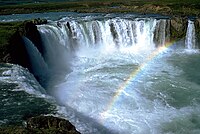
Photo from wikipedia
When an artificial surface (e.g. an asphalt road) reflects strongly and horizontally polarized light as water bodies do in the nature, polarotactic aquatic insects, like the creek-dwelling Ephemera danica mayflies… Click to show full abstract
When an artificial surface (e.g. an asphalt road) reflects strongly and horizontally polarized light as water bodies do in the nature, polarotactic aquatic insects, like the creek-dwelling Ephemera danica mayflies easily become deceived. After swarming above the creek surface, E. danica females begin their upstream compensatory flight and can be deflected at bridges with an asphalt road and continue their flight above the road surface. Thus, the water-mimicking optical signal of the road may deceive water-seeking polarotactic mayflies and lead them to distant, polarized-light-polluting surfaces, which elicit anomalous oviposition. On an asphalt road crossing a creek, we deployed polarizing insect traps at different distances from the bridge. The traps captured E. danica mayflies and their catch numbers indicated that these mayflies originated from the direction of the bridge, proving that they followed the track of the road. Our results suggest that distant polarized-light-polluting objects along an asphalt road can trap mayflies emerging from a creek crossing the road. The combination of an asphalt road and a man-made in situ (local) polarizing surface forms a complex ecological trap, being capable of luring aquatic insects from greater distances. To eliminate the oviposition of dangered polarotactic aquatic insects emerging from a creek onto the asphalt road crossing the creek, we suggest to deploy strongly and horizontally polarizing water-filled black trays along the edge of the road during the swarming period. Thus, the eggs of the deceived insects can be moved back to the creek in order to assist the conservation of the offspring-generation.
Journal Title: Journal of Insect Behavior
Year Published: 2017
Link to full text (if available)
Share on Social Media: Sign Up to like & get
recommendations!